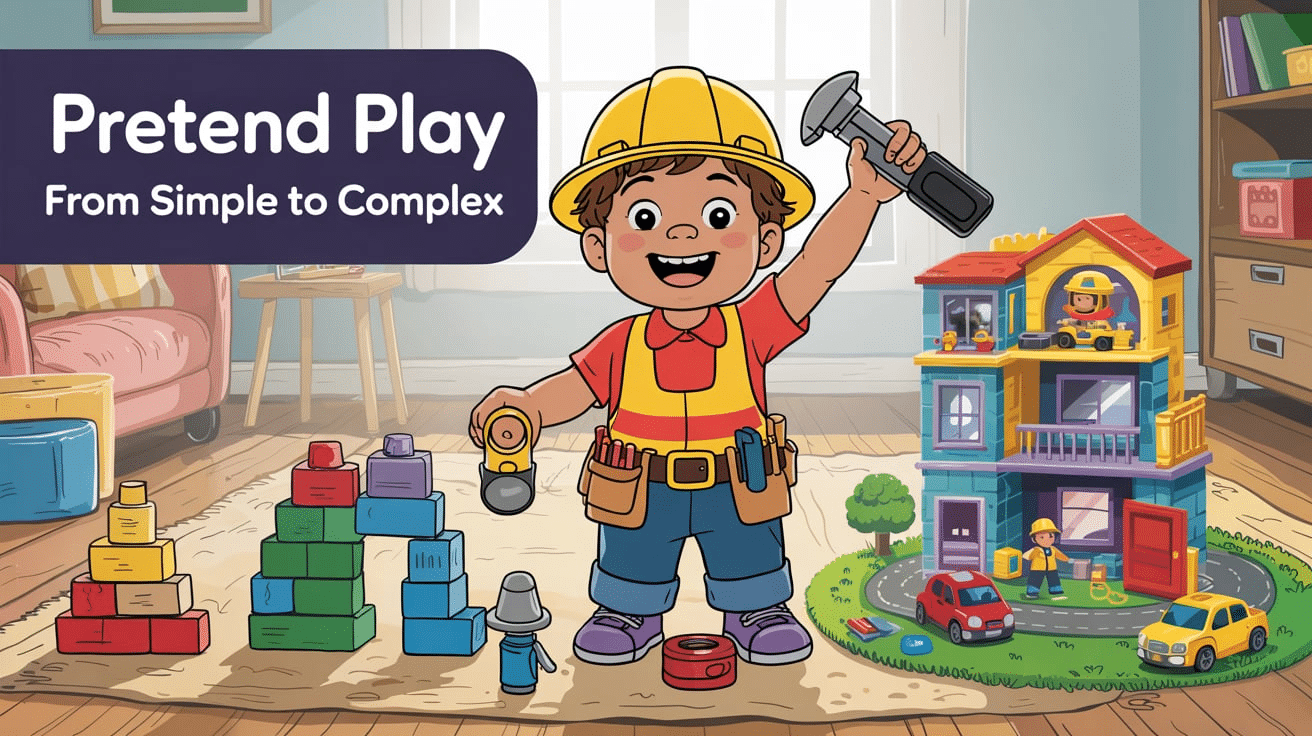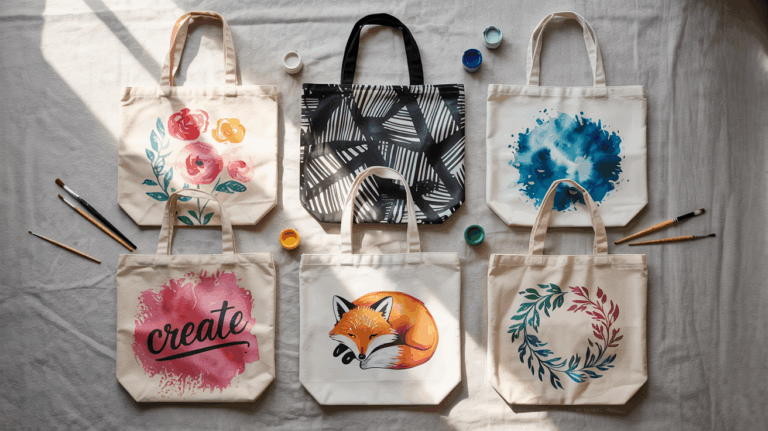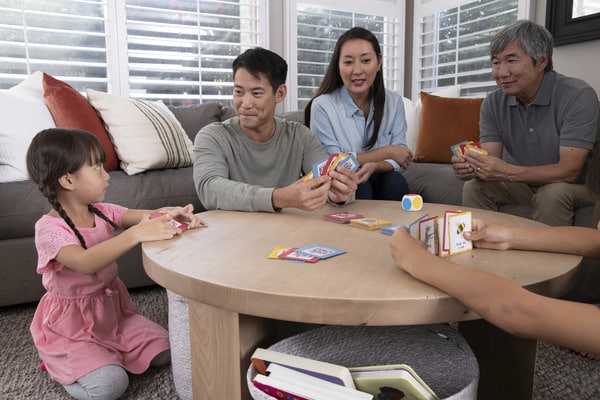Parents often notice their little ones talking to stuffed animals or turning boxes into spaceships. This creative thinking shows a child’s brain is growing in amazing ways.
Many moms and dads wonder when these magical moments of make-believe should start.
A child’s path to pretend play follows clear steps that help build social and thinking skills. Understanding these growth points can help adults support their child’s creative growth.
This blog will show the main stages when kids begin to use their imagination. It will explain what to look for at each age, how to help this type of play at home, and why this play matters so much for a child’s overall growth.
When Do Kids Start Imaginative Play?
The first signs appear between 8-12 months when babies pretend to drink from empty cups or talk on toy phones.
By 12-18 months, toddlers feed dolls or make car sounds with toy vehicles. Around 18-24 months, children begin connecting these actions into sequences, like feeding a doll and putting it to bed.
Between the ages of 2-3, kids take on roles like doctor or mommy, using objects creatively (a box becomes a house).
Full imaginative play blossoms from 3-5 years when children create detailed scenarios with rules and characters. By 5-8 years, play involves complex stories that can last for days.
Every child develops at their own pace, but these stages show how imagination grows from simple actions to rich storytelling.
Providing simple props and time for free play helps support this important development that builds creativity, social skills, and problem-solving abilities.
The Evolution of Pretend Play: From Simple to Complex

Pretend play grows in clear stages as kids develop. What begins as basic actions becomes rich storytelling over time.
First Steps: Functional Play (8-12 months)
- Using objects correctly (a toy phone to the ear)
- Copying adult actions
- No stories yet, just simple actions
Simple Pretend Play (12-18 months)
- Feeding dolls or stuffed animals
- Making car or animal sounds
- Using realistic toys
- One action at a time
Early Sequences (18-24 months)
- Connecting multiple actions (feed the doll, then put to bed)
- Beginning to use objects as substitutes
- The play is still brief and straightforward
Role Play Begins (2-3 years)
- Taking on character roles
- “I’m the doctor now.”
- Using non-realistic objects creatively
- Creating simple scenarios
Sociodramatic Play (3-5 years)
- Detailed make-believe worlds
- Staying in character longer
- Setting rules for play
- Collaborating with friends
Why Imaginative Play is a Game Changer for Your Child

Imaginative play, also called pretend play, is not just fun—it’s one of the most important ways children learn and grow.
When kids use their imagination, they create pretend worlds and stories that help them develop essential skills. Here’s why imaginative play is a game-changer for your child’s growth and development:
Boosts Creativity
Imaginative play lets children explore new ideas, scenarios, and characters. Whether they’re pretending to be superheroes, doctors, or chefs, their minds are constantly creating new stories and solutions.
This helps them become more creative as they think outside the box and come up with unique ideas.
Improves Problem-Solving Skills
When children pretend to solve problems—like fixing a broken toy or helping a stuffed animal feel better—they’re practicing real-life problem-solving.
Pretend play helps them figure out how to tackle challenges, which is a skill they’ll use in school and life.
Supports Language Development
As kids engage in imaginative play, they use language to express their ideas, thoughts, and stories.
Whether they’re making up a new game with friends or narrating a story to their toys, they practice vocabulary, sentence structure, and communication skills. This helps build their language skills in a fun and natural way.
Teaches Social and Emotional Skills
Imaginative play often involves playing with others, which helps children practice sharing, taking turns, and cooperating.
Pretending to be different characters allows them to understand various emotions and situations, helping them develop empathy and emotional intelligence.
Enhances Cognitive Growth
Imaginative play strengthens cognitive skills like memory, attention, and concentration.
For example, children remember the details of the characters and stories they create, and they need to focus to keep track of the plot. This kind of mental exercise boosts their thinking abilities.
Encourages Self-Confidence
When children make up their own pretend scenarios, they take charge of their imagination.
This boosts their confidence as they realize that they can create and control their own world. It also gives them the opportunity to practice leadership and decision-making.
Helps with Emotional Expression
Imaginative play allows children to act out situations that they might not fully understand or know how to talk about.
They can pretend to be someone else, explore different feelings, and work through tough emotions in a safe space.
Fun Ideas to Boost Your Child’s Pretend Play
It encourages creativity, imagination, and problem-solving skills by allowing children to engage in scenarios that mimic real-life situations or invent new worlds. Here are a few ways to support and enhance pretend play:
- Create a Play Space: Set up a designated area with costumes, props, and toys that can spark different role-playing opportunities. For example, a play kitchen, doctor’s kit, or a cardboard box turned into a spaceship can inspire imaginative scenarios.
- Encourage Storytelling: Read books with your child and then prompt them to act out parts of the story or create their own endings. This allows children to connect the narrative to their real-life experiences and fosters creative thinking.
- Join in the Fun: Sometimes, the best way to enhance pretend play is to actively participate. Join your child in their fantasy world and help expand the storyline or take on different roles.
- Use Everyday Items: Everyday household items, such as pots, pans, and blankets, can be transformed into tools for pretend play. A broomstick can become a horse, and pillows can turn into mountains for adventure.
- Provide Simple Challenges: Pose small challenges for your child during playtime, like “Can your pretend pirate ship find treasure?” or “How would you fix the broken car in your pretend mechanic shop?” This helps develop problem-solving and critical thinking skills within their imaginative context.
By creating opportunities for pretend play, you can nurture your child’s cognitive and social development while also giving them the freedom to explore their creativity in fun and engaging ways.
What If the Child Isn’t Engaging in Pretend Play?

Not seeing your child dive into make-believe worlds can worry you. While most kids naturally start pretend play, some take longer or show less interest.
This doesn’t always mean something is wrong, but it’s worth understanding why it might happen and what you can do to help.
Normal Differences in Play Styles
Children have their own play styles and interests. Some kids might:
- Focus more on building or physical activities
- Enjoy books or learning facts instead of pretending
- Need more time to warm up to imaginative play
- Play pretend in ways that aren’t obvious to adults
My friend’s son rarely played house or superheroes. Instead, he loved to sort things, build towers, and learn about numbers. He was developing well, just with different interests.
Possible Reasons for Limited Pretend Play
Several factors can affect how much pretend play you see:
- Temperament: Some children are naturally more practical and literal. They might prefer activities with clear rules or goals.
- Different Interests: Your child might be deeply focused on other skills like climbing, drawing, or building.
- Exposure: Kids who haven’t seen much pretend play might not know how to start.
- Need for Structure: Some children feel unsure in open-ended play and do better with some guidance.
- Processing Differences: Some kids process information differently, making spontaneous pretend play more challenging.
Simple Ways to Encourage Pretend Play
If you’d like to help your child explore imaginative play:
- Start Small: Begin with real-life scenarios they know well, like feeding a doll or talking on a toy phone.
- Follow Their Lead: Notice what interests your child and add a small pretend element to it. If they like cars, suggest the cars might be hungry or tired.
- Play Alongside: Show them how, without taking over. Say things like, “I’m pretending my bear is sleepy. He needs a bed.”
- Use Their Strengths: If your child loves order, try setting up a pretend store with items to sort and arrange.
- Keep It Short: Start with brief play sessions and gradually extend as their comfort grows.
My cousin’s daughter showed little interest in pretend games until they connected it to her love of animals. They set up a vet clinic for her stuffed animals, and her imaginative play bloomed from there.
When to Talk to a Professional
While different play styles are normal, some signs might warrant a conversation with your pediatrician:
- No pretend play of any kind by age 3
- Loss of pretend skills they once had
- Very limited social interaction, along with a lack of pretend play
- Repetitive play that doesn’t change or grow
- Other delays in language or social skills
Early support can make a big difference if your child needs extra help developing these skills.
The Bottom Line
Watching your child’s imagination blossom is one of parenting’s greatest joys. From simple pretending at 8 months to rich fantasy worlds at age 5, each stage builds important skills for life.
Remember, these milestones are guides, not strict rules. Some children focus on physical skills first, while others dive deeply into when kids start imaginative play. What matters most is that you see growth over time.
So what’s next? Try adding one simple prop to your child’s play space this week. A cardboard box, some old clothes, or even kitchen spoons can spark new, imaginative adventures.
Have you noticed a special way your child likes to pretend? Share your experiences in the comments below! Other parents might find inspiration in your child’s creative play.















